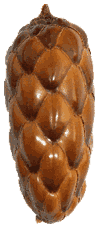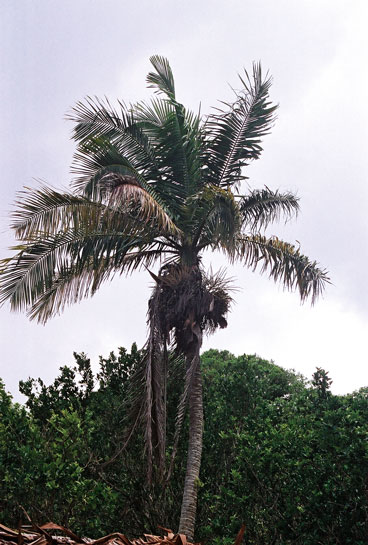 |
Palm |
 |
Palm |
Neoveitchia brunnea is native to the north of Pentecost Island (center-east of the Vanuatu archipelago, Pacific Ocean).
Medium sized palm, maximum height 8–10 meters, the stem is smooth, 30–40 cm. in diameter at breast height, enlarged at the base. The leaves are pinnate, 4–5 meters in length and fully formed in young plants. Leaflets are broad and linear. The inflorescences are large, and the elliptical fruit are ca. 8 cm long and 4 cm in diameter, red at full maturity.
Nothing is known about its pollination, seed dispersal or population structure.
This palm is among those species that form the legends of Pentecost. Known also as the"Devil Palm," Neoveitchia brunnea was reputed to pass on a deadly stomach illness to anyone that touched it. Many of the elders maintain that evil spirits fed on its fruits, and it was also believed that a poison could be concocted from its bark which could make women sterile and kill a man (Dupuyoo 2006).
Palm threatened by the expansion of cultivated land and the disrespect of traditional taboos relating to it.
 |
| Neoveitchia brunnea, Petecost Island, Vanuatu. Photo by J.-M. Dupuyoo. |
There are currently no specific conservation areas for this species. Like all other native Arecaceae, it is protected by law in Vanuatu. The Vanuatu Environment Unit have classed Neoveitchia brunnea as high priority in terms of conservation.
In addition to an extensive survey of natural stands to assess the status of this species, ex situ collections in public parks and gardens in the archipelago should be established as was done for Carpoxylon macrospermum (Port-Vila and Luganville). The villagers of Pentecost Island should be encouraged to cultivate it, and protocols for reintroduction or population supplementation should be investigated. The creation of ex situ collections in botanical gardens worldwide is advisable.
Mr. Jean-Michel Dupuyoo, Jardin d'Oiseaux Tropicaux, Conservatoire Biologique Tropical, France
Dupuyoo, J. M. 2006.
Two palms with surprising qualities.
PALMS 50: 179–183.